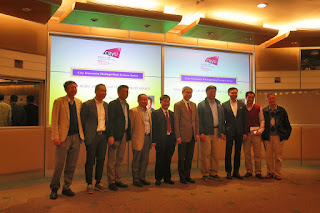Most
artificial visual systems consist of cameras and computers, like eyes and brain
of a human being, but with low level linkage model between the two parts
comparing to a human being. In this
talk, Prof. Wen Gao would like to discuss how we can improve the linkage model
to make the artificial vision system smart. Prof. Wen Gao (Member of Chinese
Academy of Engineering; Boya Chair Professor and Director of Faculty of Information
and Engineering Science, Peking University) was our guest speaker and his
presentation topic named “How to make a Visual Computing and Cognitive (VCC)
system smart”.
Firstly, Prof.
Wen Gao compared the Engineering VCC system and Hman-like VCC system. Recently,
a good tool for camera and computer linkage was Deep Learning by Neutral
Network.
Then Prof. Wen Gao briefed the eye evolution from compound eye to fish eye to bird eye and then to human eye. Biological vision system included Eyes, Pathways and Visual Field of the Brain.
And then he
compared Biological System and Artificial System of three key parts that were Digital
Retina, Networking and Cloud Computing.
VCC had four contributions
as follows:
1.
Background
Modeling based Surveillance Video Coding
2.
Visual
Feature Compression for Visual Search
3.
Joint
Rate-Distortion (R-D) and Rate-Accuracy (R-A) Optimization
4.
Standards
for digital retina
Then the
second contribution in visual feature compression was briefed. Moving Picture Experts Group (MPEG) and Compact
Descriptors for Visual Search (CDVS) were introduced. Recently, deep
convolutional neural networks (CNN)
And then he
mentioned the joint R-D and R-A optimization model
After that Prof. Wen Gao
introduced standards for digital retina such as IEEE 1857.4 for video coding
and MPEG 7-P13 for compact feature descriptor.
Prof. Wen Gao said that three steps for digital retina reality as
follows:
-
Off-line processing, edge computing
-
Using GPU etc. to implement new features
-
Using ASIC to implement new features
Finally, Prof.
Wen Gao showed his team’s recently research included coding compression and
analytical cognitive.
He
demonstrated their pulse retina chip for high speed motion such as hard disk rotation
(upto 7200 revolutions per minute (rpm)).
Group photo before lecture finished.
Reference:
CityU Distinguished Lecture Series - http://www.cityu.edu.hk/vprt/cityu-dls/upcoming-lectures.htm
CS Dept., CityU - https://www.cs.cityu.edu.hk/










沒有留言:
發佈留言